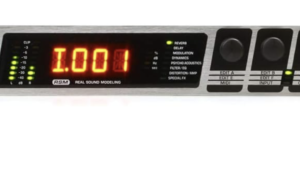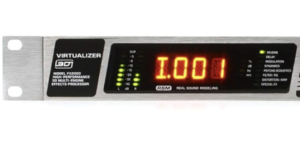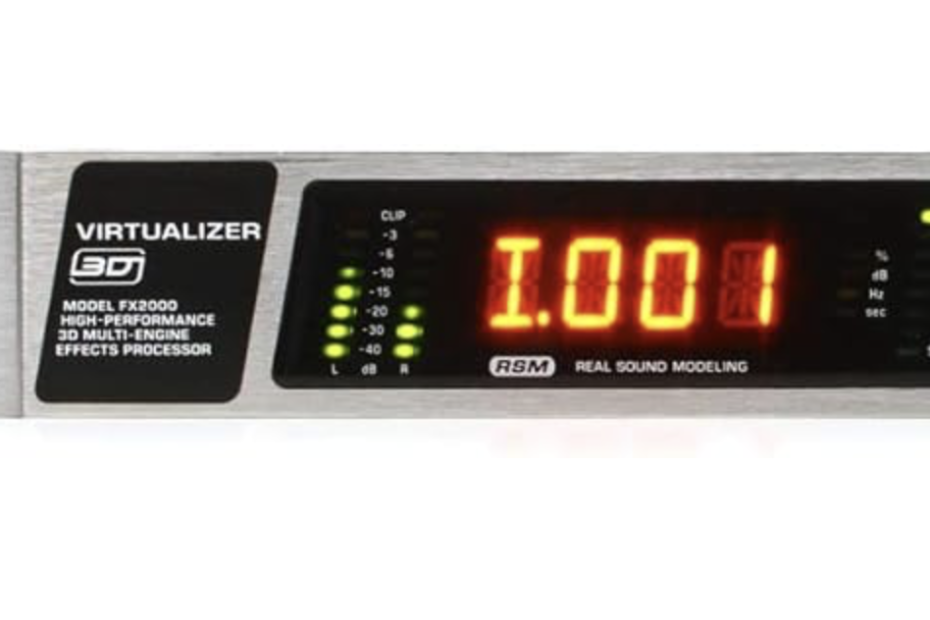The Behringer Virtualizer 3D FX2000 is a digital multi-effects processor designed for audio signal processing and enhancement. It’s part of Behringer’s line of affordable and feature-rich audio equipment.
The FX2000 is primarily used in studio environments, but it can also be utilized in live sound applications. As of my last knowledge update in January 2022, here are some key features and functionalities of the Behringer Virtualizer 3D FX2000:
Effects Processing
 The Behringer Virtualizer 3D FX2000 is equipped with a versatile effects processing engine, offering a wide range of digital effects to enhance and manipulate audio signals. Here are some details about the effects processing capabilities of the FX2000:
The Behringer Virtualizer 3D FX2000 is equipped with a versatile effects processing engine, offering a wide range of digital effects to enhance and manipulate audio signals. Here are some details about the effects processing capabilities of the FX2000:
71 Algorithms: The FX2000 provides a total of 71 different algorithms, covering various effects categories. This includes reverbs, delays, modulation effects, pitch shifting, dynamics processing, and more. The extensive selection allows users to experiment with different sounds and tailor the processing to specific applications.
The processor includes a variety of reverb algorithms for creating different room sizes, ambiances, and spatial effects. Additionally, it offers various delay options with adjustable parameters like feedback, time, and modulation, allowing users to create echoes and rhythmic effects.
Modulation effects include chorus, flanger, and phaser, providing users with the ability to add movement and texture to their audio signals. These effects are commonly used to enrich the sound of instruments and vocals.
Pitch Shifting: The FX2000 features pitch-shifting algorithms, allowing users to adjust the pitch of the input signal. This can be used creatively for harmonization or to correct pitch-related issues in vocals or instruments.
The processor includes dynamics processing algorithms, such as compressors and expanders, which can be applied to control the dynamic range of the audio signal. This is useful for ensuring a consistent volume level and adding punch to certain elements of the mix.
Also Read:
10 Best Flanger Guitar Pedals for 2024
9 Best Vocal Effects Pedals for 2024
Digitech DOD Meatbox Pedal Review
Best Multi effects Pedal for Guitar: Review
Filter and EQ Effects
 The FX2000 offers filter and EQ effects that allow users to shape the frequency response of their audio signals. This can be useful for tonal adjustments and enhancing the overall sonic characteristics.
The FX2000 offers filter and EQ effects that allow users to shape the frequency response of their audio signals. This can be useful for tonal adjustments and enhancing the overall sonic characteristics.
3D Sound Processing: One of the distinctive features of the FX2000 is its 3D sound processing capability. This is designed to add spatial depth to the audio signal, creating a more immersive and three-dimensional listening experience.
The dual-engine design of the FX2000 enables users to run two independent effects simultaneously. This flexibility allows for complex signal processing and layering of different effects.
The unit comes with preset programs covering a wide range of applications. Additionally, users can save their custom settings in the available user memory slots for easy recall during different sessions.
The front panel of the FX2000 features dedicated controls and a large LCD screen, facilitating real-time parameter control. This makes it easy for users to navigate through the various effects and customize settings on the fly.
The processor provides both relay-controlled hard-bypass and manual bypass options, allowing users to switch between processed and unprocessed signals easily.
3D Sound Processing
 The “3D Sound Processing” feature in the Behringer Virtualizer 3D FX2000 refers to a set of algorithms and effects designed to create a sense of spatial depth and dimensionality in the audio signal. This feature is intended to add a three-dimensional quality to the sound, enhancing the overall listening experience. Here are some key aspects of the 3D Sound Processing in the FX2000:
The “3D Sound Processing” feature in the Behringer Virtualizer 3D FX2000 refers to a set of algorithms and effects designed to create a sense of spatial depth and dimensionality in the audio signal. This feature is intended to add a three-dimensional quality to the sound, enhancing the overall listening experience. Here are some key aspects of the 3D Sound Processing in the FX2000:
The 3D Sound Processing aims to go beyond traditional stereo effects by adding a spatial dimension to the audio. This can create a more immersive and realistic sonic environment, making the listener feel as if the sound is coming from different directions.
The processor includes algorithms that simulate various room sizes and ambient spaces. By adjusting parameters related to reverb and spatial processing, users can tailor the perceived acoustics of the sound environment.
The 3D processing can contribute to widening the stereo image of the audio. This can be particularly useful in creating a broader sonic field for instruments and vocals, providing a sense of separation and spaciousness.
The FX2000’s 3D Sound Processing aims to enhance the depth perception of the audio signal. This can make certain elements of the mix appear closer or farther away, contributing to a more dynamic and engaging listening experience.
Enhanced Panning: Panning effects play a crucial role in the 3D processing. By manipulating the placement of sounds within the stereo field, the processor can create a more dimensional and interesting soundstage.
The 3D Sound Processing feature is not only about simulating realistic environments but also about providing creative possibilities. Users can experiment with different settings to achieve unique and artistic spatial effects.
The FX2000’s user interface typically includes controls and a display that allow users to adjust various parameters related to 3D Sound Processing. This real-time control facilitates on-the-fly adjustments to suit different musical contexts.
The 3D Sound Processing works in conjunction with other effects in the unit, allowing users to combine spatial enhancements with reverbs, delays, and other processing for a more comprehensive sonic palette.
Dual Engine Design
- The FX2000 is equipped with a dual-engine design, allowing you to run two independent effects simultaneously. This feature enhances flexibility, enabling users to create complex and layered soundscapes.
- Presets and User Memory:
- The processor comes with a variety of preset programs that cover a range of applications, from vocals to instruments. Additionally, users can save and recall their custom settings using the available user memory.
- User Interface:
- The front panel of the FX2000 features a comprehensive and user-friendly interface. It includes a large LCD screen, dedicated rotary controls, and buttons for easy navigation and parameter adjustments.
- Connectivity:
- The unit provides various connectivity options, including stereo inputs and outputs, MIDI connections, and a footswitch input for hands-free control. MIDI functionality allows for remote control and automation of parameters.
- Built-in EQ and Dynamics Processing:
- The processor includes an integrated stereo equalizer and dynamics processing. This can be useful for shaping the tonal characteristics of the processed signal and controlling dynamics.
- Bypass Options:
- The FX2000 offers both relay-controlled hard-bypass and a manual bypass switch for flexible integration into different setups.
- Rack-Mountable Design:
- The unit is designed to be rack-mounted, making it suitable for studio rack setups. It occupies 1U of rack space.
- Affordability:
- Behringer is known for producing budget-friendly audio equipment, and the FX2000 is no exception. It provides a comprehensive set of features at an affordable price point.
Using the Behringer Virtualizer 3D FX2000
Using the Behringer Virtualizer 3D FX2000 involves several steps to set up and customize the effects according to your preferences. Below is a general guide on how to use the FX2000.
Connections
Power Supply: Connect the FX2000 to a power source using the appropriate power supply.
Audio Inputs and Outputs:
- Connect your audio source (such as a mixer or instrument) to the input of the FX2000.
- Connect the output of the FX2000 to your mixer, audio interface, or amplifier.
Stereo Configuration:
- Ensure that you are using the FX2000 in a stereo configuration to fully utilize its spatial effects.
Controls and Interface:
- User Interface:
- Familiarize yourself with the controls and display on the front panel of the FX2000. It includes rotary knobs, buttons, and an LCD screen for navigating and adjusting parameters.
- Selecting Effects:
- Use the rotary knob or buttons to select the desired effects category (reverb, delay, modulation, etc.).
- Adjusting Parameters:
- Once you’ve selected an effects category, use the dedicated knobs to adjust parameters such as reverb time, delay feedback, modulation depth, etc. Refer to the LCD screen for visual feedback on parameter values.
3D Sound Processing
- Activating 3D Sound Processing:
- If you want to use the 3D Sound Processing feature, navigate to the relevant section on the FX2000.
- Adjust parameters related to spatial enhancement, room simulation, and stereo imaging to tailor the 3D effect to your liking.
